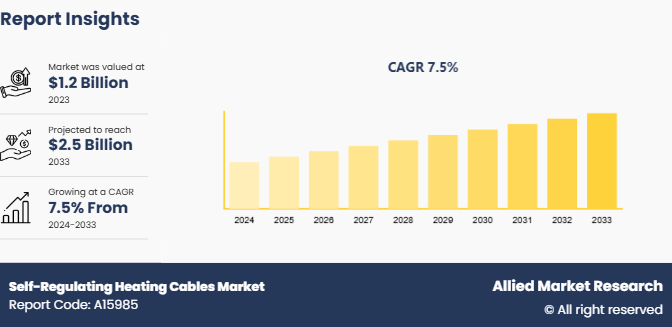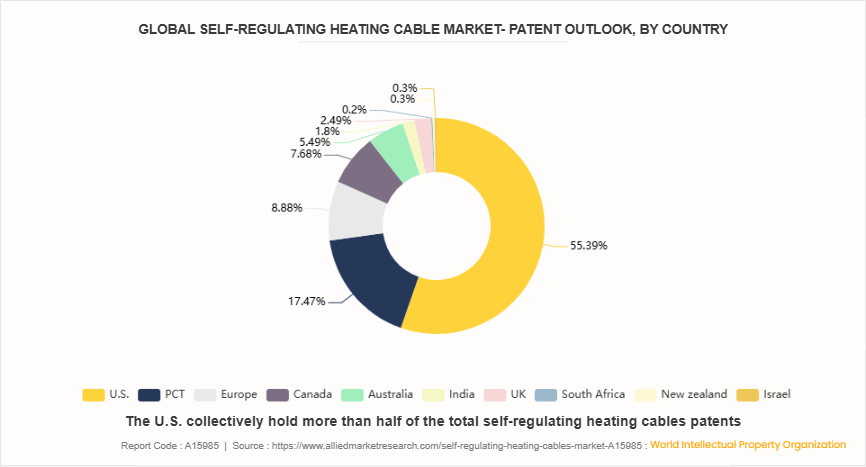Self-Regulating Heating Cables Market Research, 2033
The global self-regulating heating cables market size was valued at $1.2 billion in 2023, and is projected to reach $2.5 billion by 2033, growing at a CAGR of 7.5% from 2024 to 2033.

Market Introduction and Definition
Self-regulating heating cable are specialized electric heating cables designed to automatically adjust their heat output in response to the surrounding temperature. This self-regulation occurs due to the unique construction of the cable, which typically consists of a conductive polymer core that changes its electrical resistance with temperature variations. When the ambient temperature decreases, the cables resistance decreases, allowing more electrical current to flow and generating more heat.
Key Takeaways
- The self-regulating heating cables market report covers 20 countries. The research includes a segment analysis of each country in terms of value ($billion) for the projected period 2023-2033.
- More than 1,500 product literatures, industry releases, annual reports, and other such documents of major self-regulating heating cables industry participants along with authentic industry journals, trade associations' releases, and government websites have been reviewed for generating high-value industry insights.
- The study integrated high-quality data, professional opinions and analysis, and critical independent perspectives. The research approach is intended to provide a balanced view of global markets and to assist stakeholders in making educated decisions to achieve their most ambitious growth objectives.
Key Market Dynamics
The demand for self-regulating heating cables in the industrial sector is primarily driven by the critical need for temperature maintenance in various processes. These innovative cables automatically adjust their heat output based on ambient temperature changes, providing efficient and reliable temperature control without the need for complex thermostats or control systems. Industries such as oil and gas, chemical processing, food and beverage, and pharmaceuticals rely heavily on maintaining precise temperatures for their operations, product quality, and safety. Self-regulating heating cables offer advantages like energy efficiency, reduced maintenance costs, and improved process stability, that make them increasingly popular for applications such as pipe freeze protection, tank heating, and process temperature maintenance. All these factors are expected to drive the demand for the self-regulating heating cables market forecast period.
However, the growth of the self-regulating heating cables market faces a significant challenge due to high initial installation costs. While these cables offer numerous benefits in terms of energy efficiency and long-term operational savings, the upfront investment required can be substantial. The cost includes the cables themselves and associated components such as power connection kits, end seals, and control systems. All these factors are expected to hamper the self-regulating heating cables market growth. Smart heating technologies integrate sensors, control systems, and connectivity features that allow for precise temperature management, energy efficiency, and remote monitoring. Self-regulating heating cables, which adjust their heat output based on the surrounding temperature, complement these technologies perfectly. This synergy enhances the overall efficiency and effectiveness of heating systems, that make them more appealing to industries and consumers looking to optimize energy use and reduce costs. All these factors are anticipated to offer new growth opportunities for the self-regulating heating cables market during the forecast period.
Patent Analysis for Self-Regulating Heating Cables Market

The U.S. collectively hold more than half of the total self-regulating heating cables patents that indicate strong innovation and investment in this technology in U.S. countries. This suggests fierce competition and a significant focus on self-regulating heating cables R&D in these leading economies. U.S. has the highest patent filed those accounts for 55.5% of the total global patents related to the self-regulating heating cables market. Europe and PCT, although holding smaller percentages of self-regulating heating cables patents individually, collectively contribute to the overall Asian dominance in self-regulating heating cables innovation. This reflects the region's strong presence in materials science and engineering R&D.
Market Segmentation
The self-regulating heating cables market is segmented by type, end-use industry, and region. Based on type, the market is classified into parallel heating cables, self-regulating heating cables, industrial heating cables, and others. By end-use industry, the market is divided into oil and gas, building and construction, chemical, mining, and others. Region-wise, the market is analyzed across North America, Europe, Asia-Pacific, and LAMEA.
Regional Market Outlook
The North America region harsh climatic conditions, especially in Canada and the northern United States, create a strong demand for efficient heating solutions to prevent freezing and maintain operational integrity in residential, commercial, and industrial. The robust industrial base, particularly in sectors such as oil and gas, chemical processing, and food and beverage, relies heavily on these cables to ensure safe and efficient temperature maintenance. In addition, North America focus on technological advancements and smart building technologies has led to the integration of self-regulating heating cables with advanced automation systems, enhancing energy efficiency and user convenience.
Competitive Landscape
The major players operating in the Self-Regulating Heating Cables Market include Thermon Group Holdings, Inc., Emerson Electric Co, BARTEC Top Holding GmbH, Chromalox, SST Group, Heat Trace Products, LLC, Drexan Energy Systems, Inc., Warmup PLC, Heatron, Inc., Flexelec, and others.
Industry Trends
- There is a growing emphasis on energy-efficient and sustainable heating solutions. Self-regulating heating cables, which adjust their heat output based on ambient temperatures, align well with this trend by reducing energy consumption and minimizing environmental impact.
- The increasing adoption of smart home and building technologies is a significant trend in the self-regulating heating cables market. These cables are being integrated with IoT devices and automation systems, allowing for remote monitoring and control.
Key Sources Referred
- Institute of Electrical and Electronics Engineers
- Invest India
- International Renewable Energy Agency (IREA)
- India brand Equity foundation (IBEF)
- International Energy Agency (IEA)
Key Benefits For Stakeholders
- This report provides a quantitative analysis of the self-regulating heating cables market share, segments, current trends, estimations, and dynamics of the self-regulating heating cables market analysis from 2024 to 2033 to identify the prevailing self-regulating heating cables market opportunities.
- The market research is offered along with information related to key drivers, restraints, and opportunities.
- Porter's five forces analysis highlights the potency of buyers and suppliers to enable stakeholders make profit-oriented business decisions and strengthen their supplier-buyer network.
- In-depth analysis of the self-regulating heating cables market segmentation assists to determine the prevailing market opportunities.
- Major countries in each region are mapped according to their revenue contribution to the global market.
- Market player positioning facilitates benchmarking and provides a clear understanding of the present position of the market players.
- The report includes the analysis of the regional as well as global self-regulating heating cables market trends, key players, market segments, application areas, and market growth strategies.
Self-Regulating Heating Cables Market Report Highlights
| Aspects | Details |
| Market Size By 2033 | USD 2.5 Billion |
| Growth Rate | CAGR of 7.5% |
| Forecast period | 2024 - 2033 |
| Report Pages | 340 |
| By Type |
|
| By End-Use Industry |
|
| By Region |
|
| Key Market Players | Chromalox, Inc., SST Group, Heat Trace Products, LLC, BARTEC Top Holding GmbH, Heatron, Inc., Drexan Energy Systems, Inc, Warmup PLC, Flexelec, Thermon Group Holdings, Inc., Emerson Electric Co |
Energy efficiency and cost savings, Growing demand for energy-efficient heating solutions are the upcoming trends of Self-Regulating Heating Cables Market in the world.
Oil and gas is the leading application of Self-Regulating Heating Cables Market.
North America is the largest regional market for Self-Regulating Heating Cables
$2.5 billion is the estimated industry size of Self-Regulating Heating Cables by 2033.
Thermon Group Holdings, Inc., Emerson Electric Co, BARTEC Top Holding GmbH, Chromalox, SST Group, Heat Trace Products, LLC, Drexan Energy Systems, Inc., Warmup PLC, Heatron, Inc., Flexelec, and others are the top companies to hold the market share in Self-Regulating Heating Cables
Loading Table Of Content...



